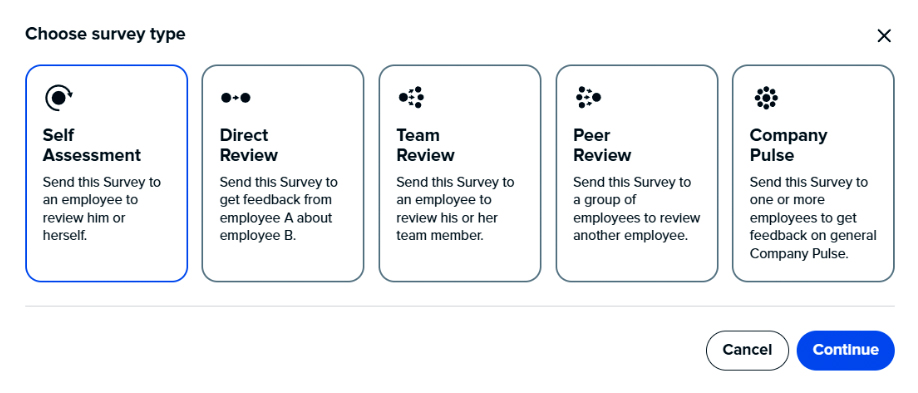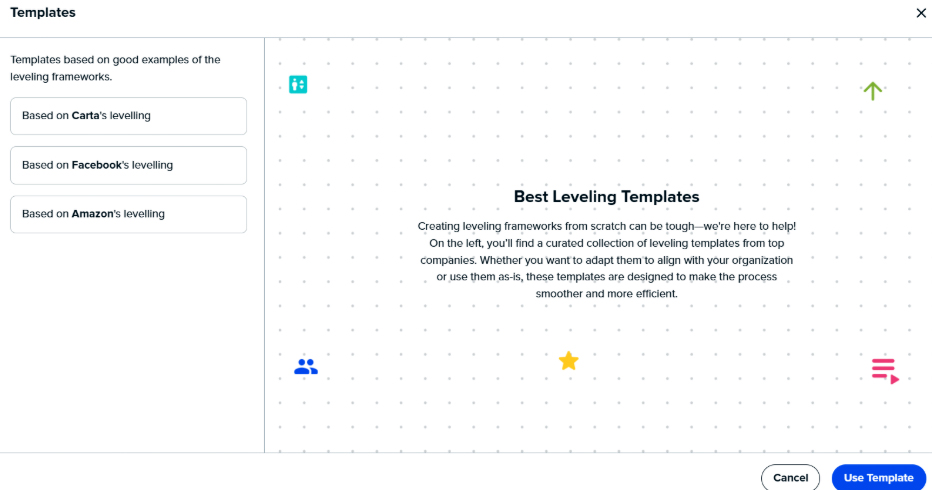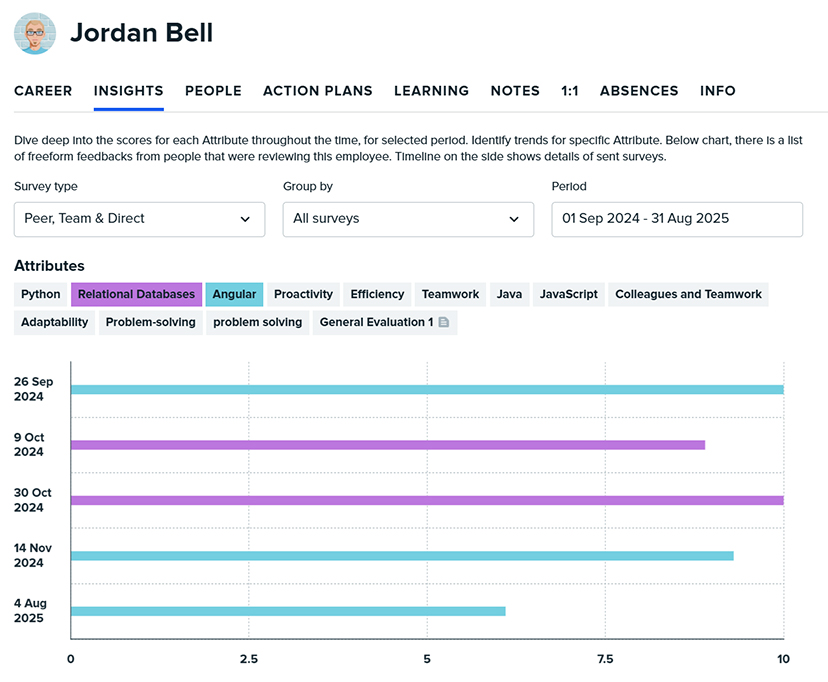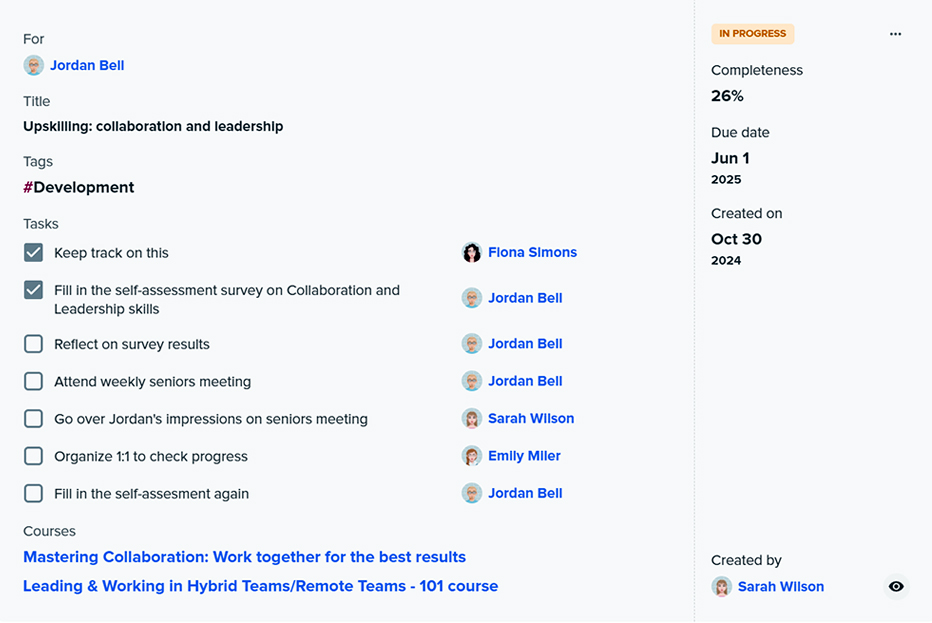Most teams want to provide fair and helpful feedback, but few feel confident in their performance review process. It often starts as a side task and ends up as a source of stress for everyone involved.
If you’re Googling the meaning of performance review, you’re likely facing one of two problems:
You’re building a process from scratch, or you’re stuck with one that no longer works.
Most tech teams start simple: a spreadsheet, a few bullet points, maybe a Google Form. However, as the company expands, performance reviews often become complicated, with unclear feedback, inconsistent criteria, and a lack of direct connection to career development.
So, what should a performance review actually mean? And how do you build one that brings clarity instead of confusion, especially in a fast-moving, project-driven team?
The traditional meaning of performance review (and why it breaks in tech)
Most companies have done performance reviews for years. But that doesn’t mean they’re doing them well or that they understand what the process is supposed to achieve.
Let’s start with where the concept comes from.
What performance reviews used to mean
In traditional setups, the meaning of performance review was primarily administrative. It was a once-a-year sit-down where managers summarized past work, gave a performance rating, and linked that rating to a bonus or raise.
Reviews were top-down, one-directional, and based almost entirely on the manager’s perception, often without input from peers, the employee, or any structured framework.
For older, hierarchical companies with slow-changing roles, this approach made sense. But it doesn’t hold up in more dynamic environments.
Why that model fails for tech teams
In modern tech teams, responsibilities shift quickly. A designer might start mentoring. A developer might step into a client-facing role. These changes don’t wait for an annual review to be acknowledged.
Trying to assess performance retroactively based on vague notes or gut feeling creates inconsistency. Without clear criteria or multiple perspectives, it’s easy to miss progress or reward the wrong things.
This is where reviews lose meaning. They stop being beneficial for the employee, frustrating the manager, and doing little for the team. Worse, they can damage trust when perceived as arbitrary or disconnected from daily work.
That’s why so many tech teams end up skipping them entirely or going through the motions without tangible outcomes.
One high-profile example of this shift is Microsoft’s performance management approach. The company moved away from its once-notorious stack ranking system, in which employees were rated and ranked against one another, after recognizing that it created internal competition and hindered collaboration.
Instead, Microsoft shifted its focus to ongoing feedback and individual development. The new approach helped improve performance, team trust, and overall engagement, proving that meaningful reviews aren’t about labels, but about progress.
Rethinking the meaning of performance review for tech teams
Not every team defines performance the same way, and that’s precisely the problem. Reviews often turn into a routine or a checkbox, even in companies that care deeply about growth. For tech teams, especially, the traditional approach often falls short.
The meaning of a performance review needs to reflect how work is done across roles, feedback loops, and shifting responsibilities.
From formality to alignment
Reviews that rely on vague forms and scattered impressions tend to create friction. Employees don’t know what’s expected. Managers don’t always have the whole picture. And the conversation stays one-sided.
When the focus shifts to alignment, the review becomes more than a judgment; it’s a shared moment to clarify direction. It opens up space for people to talk about how they work, what’s blocking them, and where they want to grow. This doesn’t require elaborate rituals; it just needs a structure that everyone can understand and trust.
Continuous visibility, not annual check-ins
Tech roles evolve fast. Someone might switch projects, take on new responsibilities, or grow in ways that aren’t visible in standard HR reports. By the time an annual review comes around, half of that progress is already lost to memory.
Instead of one big moment, teams benefit more from small, ongoing signals, such as regular 1:1s, short written feedback, and visible progress in skills. When reviews are part of a continuous loop, they become easier to run and more helpful to act on.
💡 According to Gallup, 80% of employees who receive meaningful feedback every week are fully engaged, which presents a sharp contrast to the results of traditional, once-a-year reviews.
Clear inputs, shared ownership
Performance conversations carry more weight when they’re based on input from multiple sources. When the manager’s perspective is the only one on the table, it’s easy to miss context or fall into bias, even without realizing it.
A stronger setup brings in self-assessment, peer feedback, and clear criteria that are consistent across roles. This gives everyone a shared reference point. It also builds trust, as the process feels transparent, rather than a black box with a score at the end.
That’s where the meaning of performance review starts to change: it becomes a process people can engage with, not just endure.
Why common setups still don’t work
Even when teams try to improve performance reviews, the fixes often fall short. It’s not due to a lack of effort. It’s because the tools and methods don’t match how tech teams operate.
Here’s where most setups break down.
1. Everything lives in a spreadsheet
It starts simple: a table, a few questions, and some scoring logic. But as the team grows, columns multiply, context gets lost, and no one is quite sure what the numbers mean anymore. What was meant to bring structure ends up creating even more confusion.
2. Feedback is scattered across tools
Some notes are in Slack, others in Notion, and the rest are just remembered during a meeting. Without a central place to collect and compare feedback, reviews become a guessing game. Managers piece together a narrative from fragments, and it often fails to reflect the whole picture.
3. Survey tools gather data, but don’t guide decisions
You might get answers to your questions, but then what? When there’s no framework behind the feedback, managers are left to interpret results without context. That opens the door to inconsistent decisions and unclear next steps.
4. Most HR platforms focus on admin, not growth
Most traditional HR tools were designed to track data, rather than support team growth. They store evaluations, but don’t help managers run more effective conversations or identify growth signals. For teams that move quickly and rely on skills, that’s a significant gap.
Tech managers and HRs don’t need another place to log reviews. They need a system that helps them understand people better, align expectations, and make fair, timely decisions. That’s something most “good enough” setups can’t deliver.
💡 According to Gallup, traditional performance reviews make performance worse about one-third of the time, largely because they’re infrequent, untimely, or poorly structured.
What does a performance review look like in Kadar?
Once reviews are no longer a guessing game, they become something far more useful: a shared source of insight. This is precisely what Kadar enables, without adding overhead or complexity.
A shared truth: self, peer, manager
Understanding someone’s growth shouldn’t depend on a single opinion. In Kadar, each review is built on three perspectives: self-assessment, peer feedback, and the manager’s input. Instead of treating these as separate exercises, Kadar displays them side by side, making differences in perception easy to spot and discuss.
And if you're unsure how to interpret the results, our team is always here to help. Kadar’s support isn’t limited to setup; we stay available throughout, so managers and HRs don’t have to figure things out alone.
In project-based teams, it’s often helpful to gather input from clients as well. Kadar makes this possible by allowing you to include external associates in the performance review process without requiring additional paid licenses. This provides teams with a more comprehensive view of performance, particularly in service-oriented environments where client feedback is just as valuable as internal input.
This comparison isn’t just informative. It opens up honest conversations about confidence gaps, overlooked contributions, and inconsistent expectations.
When you see that a developer rates themselves lower than everyone else, that’s not just a data point. That’s a reason to talk.
💡 According to Gallup’s CliftonStrengths study, teams that use 360-degree feedback see performance improvements of 8–18%, and up to 73% lower attrition. When feedback is multi-sided, consistent, and structured, it doesn’t just inform, it actually drives measurable results.
From insight to action
Information alone doesn’t drive change. That’s why Kadar connects review results directly to individual action plans. Based on the review, the manager and employee can define specific skills to develop, set learning goals, and track follow-ups in future 1:1s.
One place to track progress
Rather than leaving reviews in a document that gets forgotten, Kadar makes growth visible over time. You can return to the same view during the next cycle and see precisely what’s improved and what still needs work.
Growth becomes visible
Kadar’s leveling framework adds structure to feedback that’s often hard to quantify. Instead of saying “you’re doing great,” managers can point to where someone is within a well-defined skill path. This clarifies expectations and makes progress easier to recognize for both parties.
It also reduces uncertainty. Employees know what’s expected, how their skills are evolving, and what comes next. Managers know who’s ready for more responsibility and why.
How Kadar fits into your workflow (and why that matters)
When most teams start looking for a performance management tool, they’re not looking for complexity. They want structure, and they want it to be actually usable, not just impressive in a demo.
That’s where Kadar stands out. It’s not a system you implement. It’s the one you start using.

Starting the process: no blank screen, no confusion
You don’t need to build forms from scratch or define criteria before you begin. Kadar provides a clear structure, including example surveys, skill levels, and feedback formats, so teams aren’t starting from zero. And if you’re unsure how to apply it to your team, our support team is there to help.
The result? Most teams get started quickly, even without prior experience. The interface is intuitive, and our team is available to support you, not just during onboarding, but also whenever questions arise. The tool feels familiar from the start, especially to tech teams used to logical flows and clean interfaces.

Making progress visible, without extra admin
Most tools collect data. Kadar goes one step further — it connects that data to growth. As reviews are completed, feedback is integrated directly into action plans and learning goals, all of which are tracked in one place.
This means no separate sheets, follow-up reminders, or extra dashboards. The manager sees where each person stands, what’s changed since last time, and what’s coming next, without switching tools or copying notes.

And because everything is tied to skills and levels, there’s no ambiguity. Everyone knows what “good” looks like and what needs to happen to get to the next step.

Time to redefine the meaning of performance review in your team
When reviews are unclear, delayed, or based on scattered impressions, they cease to be useful. Still, with the proper setup, they can become one of the most valuable signals for team alignment, growth, and retention.
The meaning of performance review doesn’t have to be vague. It can mean shared visibility, structured feedback, and clear next steps, not just for the employee, but for the entire team.
If your current process feels like a mix of spreadsheets, guesswork, and inconsistent expectations, it’s probably time to try a more straightforward way.
Kadar gives you the structure from day one, with examples, clear flows, and support when you need it. And because Kadar is free to start, you can test it with one team and see what works, without needing to push for a big decision right away.
Try Kadar for free and see how clarity changes everything.





